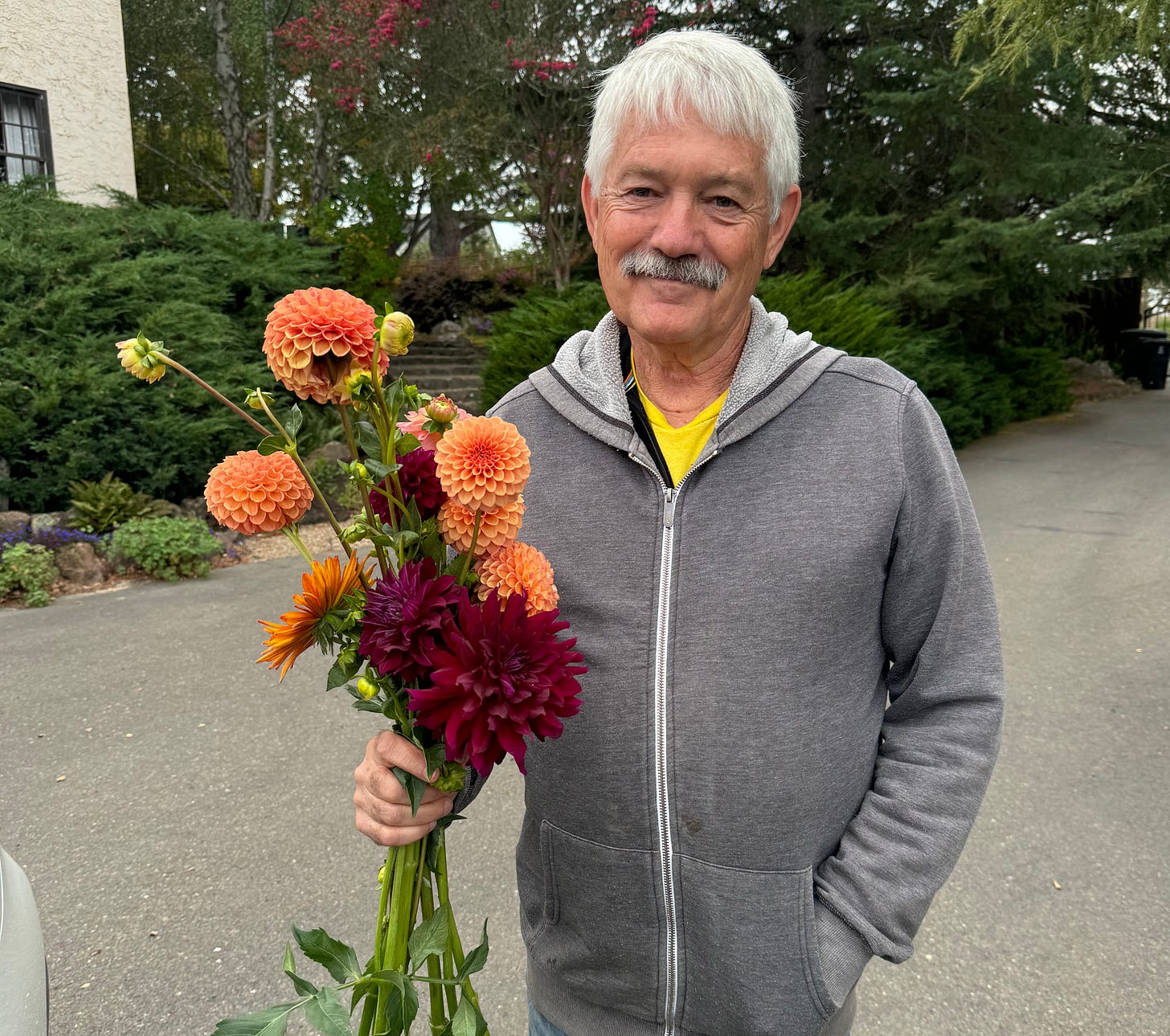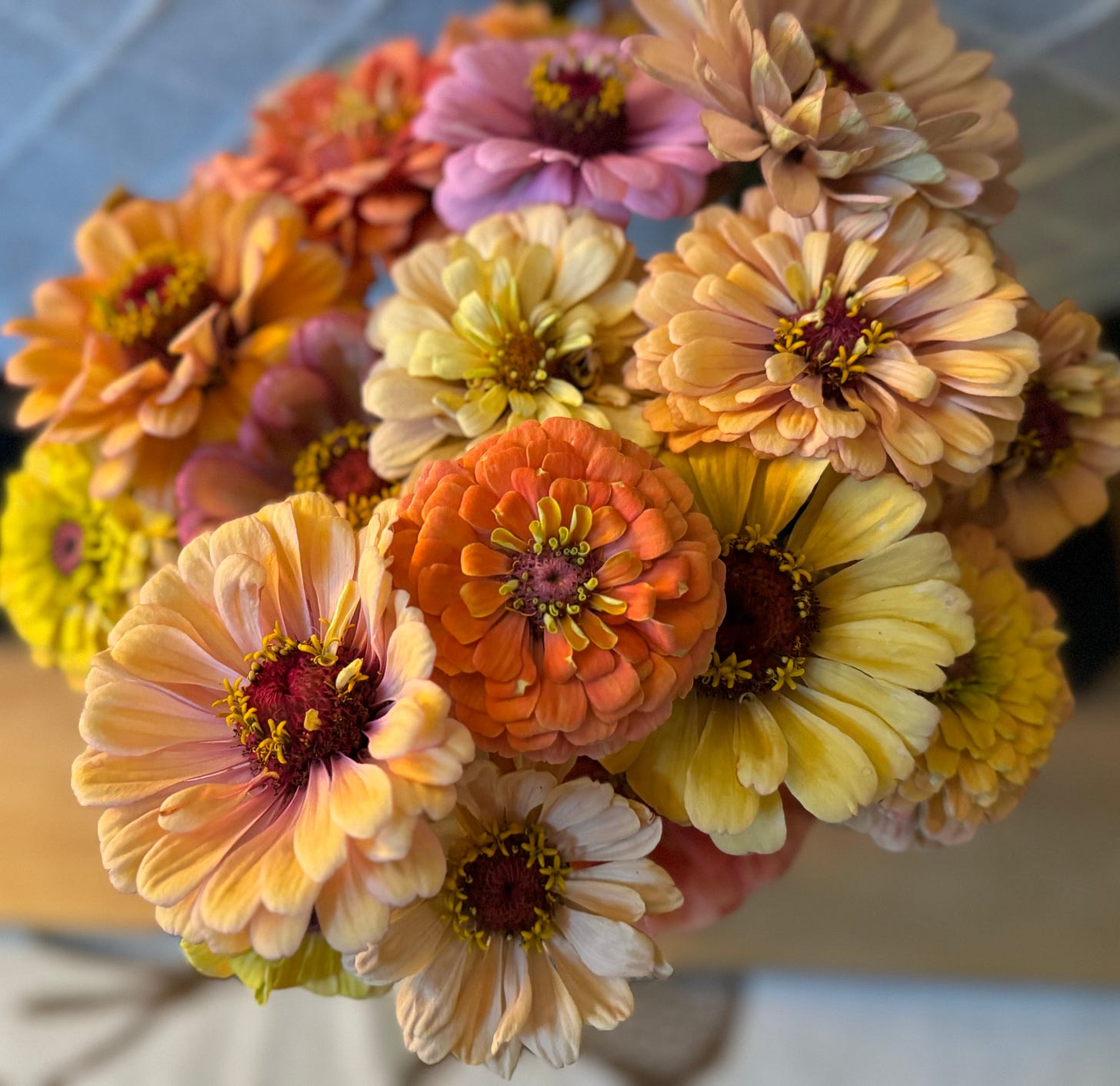The power of flowers
Starting last summer, Grace Bartlomé and friends created a project called Beauty to Elders, growing flowers and bringing bouquets to isolated seniors at Burbank Heights and Orchards

It all began with a single flower.
Grace Bartlomé was standing outside of her apartment building at Burbank Heights when she was approached by someone carrying a single daffodil.
“A neighbor of mine is 100 years old, and I had never met her, but a friend of hers handed me a daffodil one day and said, ‘Why don’t you take this up to Betty?’ And I said, ‘Well, I haven’t met Betty.’ And she said, ‘She loves flowers.’ So I brought it to her, and she wept.”
Later, after taking a floral design class that produced some extra bouquets, Bartlomé took Betty a whole bouquet. ‘Again, she wept,” Bartlome said. “And it just got me thinking, ‘I wonder how many Betties there are here in this complex?’”
Before she retired, Bartlomé was a small-scale flower farmer, who sold her flowers at local farmers markets.
“I was itching to grow flowers again on a larger scale,” she said.
Burbank Heights gives residents small raised beds in the community garden, but that wasn’t large enough for Bartlomé’s ambitions. Instead she got involved in the Burbank Experiment Farm next door and ultimately got permission to plant in the farm’s Demonstration Garden.
They asked me, “‘Well, what would you grow?’ and I said, ‘I would grow zinnias because I really miss them, and they’re so powerful, and they love this climate.’”
She grew two rows of zinnias: “One row of rare floret pastels and one row of mixed—California Kings, Green Envy, just a lot of different unique ones,” she said.
Bartlomé knew she wanted to give bouquets of flowers away to isolated seniors at Burbank, but she hadn’t quite figured out the details of how that would work. Then her zinnia garden at Burbank Farm drew the attention of John Baker, who was growing a whole yardful of dalias and roses, a few blocks away. When he learned about her idea for giving away bouquets, he invited her to come pick as many dahlias as she wanted.
Bartlomé took Baker up on his offer.
“We just picked buckets and buckets of flowers,” Bartlomé said. “I put them in my car. I went, ‘Okay, this is happening.’ I had told several people about this idea, and one of them was Deb Hopecarter. So I called and said, ‘Deb, are you busy? I have buckets of flowers. Do you want to make some bouquets with me?’ And she was like, ‘Yeah, right on!’ We made 25 bouquets the first day.”
Then they went to the management of Burbank Heights and asked for a list of people who were isolated or who didn’t get out much and who could benefit from the bouquets.
“So we just went out and tapped on doors and said, ‘We have a bouquet for you. Would you like some flowers?’ Quite a few people just wept, incredulous—just to be remembered.”
“We started doing this almost weekly,” Bartlomé said, “and we started finding that there’s more connection going on than flowers. After the deliveries, Deb and I would get back to each other and say, ‘Oh my God, this is just amazing.’ We hadn’t even thought about what we were going to get back and how good it was going to feel to be doing this.”
They named the project Beauty to Elders. “This beauty was percolating through the community and through our lives as well,” Bartlomé said.
So then the question arose of how to keep it going.
“I had a lot of zinnias, and John had a lot of dahlias, a lot of roses, but eventually I had the idea that I could talk to local flower farmers,” she said.
As a former flower farmer herself, Bartlomé knew that flower farmers often returned from farmers markets with buckets of flowers that hadn’t sold. She reached out to several farms—Poppies and Petals, Dew Drop and Chokamalichi—who offered their extra flowers.
Beauty to Elders grew, and more people, like Ellen Sennewald and Caverly Whittemore at Burbank Heights, got involved in helping to make the bouquets and delivering them. In addition to growing the flowers, picking them up from flower farms, and making bouquets, there was also other work to do—like getting the mason jar vases, picking them up from bouquet recipients after a week or so, and washing them, and getting them ready for the next bouquet.
“It was a lot of work,” Bartlomé admits, “but I had lots of community support.”
Flowers are seasonal things, and the project wound down toward the end of October. Beauty for Elders is taking a break over the winter, but like most inveterate gardeners, Bartlomé is already looking forward to spring. She got permission from the Burbank Experiment Farm to plant more zinnias this year. Chokamalichi Farm, which last year let Bartlomé and friends pick their leftovers, is planning on planting an entire row dedicated to Beauty for Elders.
“The true learning for us was service is love,” Bartlomé said. “We didn’t start out to be doing anything for ourselves—we didn’t even have that on our radar—yet there we were. We felt like we were the true recipients of what was happening. We have all heard from Ram Dass, of course, that service is love, but having it land cellularly, like in your being, was such an experience for all of us, especially at delivery time. It’s also a lot of fun.”
“Going to people’s homes and bringing them beauty with no attachment and just sitting down and hearing their story for that day, we started to realize this was not just about delivering flowers,” she said. “It was a connection to what’s really important, right? And we were the true recipients of the gift in the end, that’s what we saw. Flowers were an entry into something so much bigger than any of us could have imagined.”










What a fabulous story. Thank you. ❣️
Beautiful idea, people, and flowers. All coming together to share love. Thank you for this story!